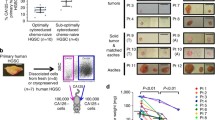Summary
Adolezesin is an analog of CC-1065. These compounds are among the most potent alkylating agents known to date. Currently Adolezesin is undergoing phase I clinical trials at several cancer centers in the USA. While the cytotoxic effects of Adolezesin have been addressed elsewhere, its effects on cell-cycle kinetics have not been reported. Flow cytometry was performed on five human gynecological cancer cell lines: AN3, AE7, BG1, HEC1A, and SKUT1B. Exposure to Adolezesin (U73975, Upjohn Co.) was done at near confluency at 0, 0.1, 0.2, 0.5, 1 and 5x, withx=10 pg/ml as reference concentration, for 90 min. Cell samples were taken by trypsinization at 0, 24, 48, 72, 96, and 168 h for flow cytometry. The ATP chemosensitivity assays were performed on the above cell lines to establish dose/response curves. Flow-cytometric analyses revealed that there was a spectrum of cell-cycle perturbations, which included biphasic S and G2 blocks, reverse dose-dependent G2 blocks, and a sequential relationship of S and G2 blocks. This study demonstrated that the cell kinetic response to Adolezesin depended on several variables such as cell lines, drug sensitivity, concentrations, and sampling time. Because of this multivariable dependence and the lack of correlation with cytotoxicity, it would be difficult to use cell kinetic pertubations to predict chemotherapeutic response.
Similar content being viewed by others
References
Alberts D, Elnspahr J, Sipes IG (1989) In vitro cytotoxicity of a novel DNA minor groove binding anticancer, agent (U-73975) against doxorubicin sensitive and resistant human tumor cell lines. Proc Am Assoc Cancer Res: abstract 1957
Averette HE, Weinstein GD, Frost P (1970) Autoradiographic analysis of cell proliferation kinetics in human genital tissues. Normal cervix and vagina. Am J Obstet Gynecol 108:8–17
Barlogie B, Drewinko B (1978) Cell cycle stage-dependent induction of G2 phase arrest by different antitumor agents. Eur J Cancer 14:741–745
Barlogie B, Raber MN, Schumann J, Johnson TS, Drewinko B, Swartzendruber DE, Gohde W, Andreeff M, Freireich EJ (1983) Flow cytometry in clinical cancer research. Cancer Res 43:3982–3997
Bhuyan BK, Crampton SL, Adams EG (1983) Cell cycle effects of CC-1065. Cancer Res 43:4227–4232
Chou T, Talaly P (1984) Quantitative analysis of dose-effect relationships: the combined effects of multiple drugs or enzyme inhibitors. Adv Enzyme Regul 22:27–55
Dekoning TF, Krueger WC, Wallace TL, Prairie MD, Warpehoski MA, et al. (1987) Influence of structure and chirality on the antitumor activity and biochemical effects of CC-1065 and its analogs. Proc Am Assoc Cancer Res 28:262
Dethlefsen L, Riley R, Roti R (1979) Flow cytometric analysis of Adriamycin-perturbed mouse mammary tumors. J Histochem Cytochem 27: 463–469
Hanka LJ, Dietz A, Gerpheide SA, Kuentzel SL, Martin DG (1978) CC-1065 (NSC-298223), a new antitumor antibiotic. Production, in-vitro biological activity, microbiological assay, and taxonomy of the producing organism. J Antibiot 31:1211–1217
Hill BT, Bellamy AS (1984) An overview of experimental investigations of interactions between certain drugs and X-irradiation in vitro. In: Advances in radiation Biology, vol 11. Academic Press, New York, pp 211–267
Kingston RE, Sevin BU, Ramos R, Saks M, Donato DM, Jarrell MA, Averette HE (1988) Synergistic effects of cis-platin (CP) and cytosine arabinoside (CA) on ovarian cell lines demonstrated by dual parameter flow cytometry. Gynecol Oncol 3:282–287
Martin DG, Chidester CG, Duchamp DJ, Mizask SA (1980) Structure of CC-1065 (NSC298223), a new antitumor antibiotic. J Antibiot 33:902–903
Maybaum J, Ting P, Rogers CE (1989) Prediction of thioguanine-induced cytotoxicity by dual-parameter flow cytometric analysis. Cancer Chemother Pharmacol 24:291–294
Muss HB (1990) Principles of cancer chemotherapy. In: Deppe G (ed) Chemotherapy of gynecologic cancer, 2nd edn. Liss, New York, pp 1–41
Neubauer A, Sauer H, Valet G (1987) Cytostatic drug testing in human leukemias by means of multiparametric flow cytometry. Blut 55:433–445
Reynolds VL, McCovren JP, Hurley LH (1986) The chemistry, mechanism of action and biological properties of CC-1065, a potent antitumor antibiotic. J Antibiot 39:319–334
Sevin BU (1990) DNA analysis and cell kinetics in gynecologic malignancies. In: Deppe G (ed), Chemotherapy of gynecologic cancer, 2nd edn. Wiley, New York, pp 443–461
Sevin BU, Ramos R, Averette HE (1983) The potential use of cell kinetics in the treatment of ovarian malignancies. In: Grundmann E (ed) cancer campaign, carcinoma of the ovary, vol 7. Fisher, New York, pp 23–38
Sevin BU, Pollack A, Averette HE, et al. (1986) In vivo chemosensitivity testing in patients with gynecologic malignancies and nude mouse xenografts by monitoring cell kinetic parameters and DNA distribution patterns: a preliminary report. Gynecol Oncol 24:27–40
Sevin BU, Peng Z, Perras J, Ganjei P, Penalver M, Averette HE (1988) Application of an ATP-bioluminescence assay in human tumor chemosensitivity testing. Gynecol Oncol 31:191–204
Swenson DH, Li LH, Hurley LH, Rokem JS, Petzold GL, Dayton BD, Wallace TL, Lin AH, Krueger WC (1982) Mechanism of interaction of CC-1065 (NSC298223) with DNA. Cancer Res 42:2821–2828
Thigpen JT (1987) Chemotherapy. In: Morrow CP, Townsend D (eds) Synopsis of gynecologic oncology, 3rd edn. Wiley, New York, pp 412–458
Tobey R, Oka M, Crissman H (1979) Analysis of effects of chemotherapeutic agents on cell-growth kinetics in cultured cells. In: Melamed M, Mullaney P, Mendelsohn M (eds) Flow cytometry and sorting. Wiley, New York, pp 573–582
Tsurusawa M, Sasaki K, Matsuoka H, Yamamoto Y, Katano N, Fujimoto T (1986) Flow cytometric analysis of marrow cell kinetics in children treated with high-dose MTX and CF rescue. Cancer Chemother Pharmacol 16:277–281
Tsurusawa M, Niwa M, Katano N, Fujimoto T (1988) Flow cytometric analysis by bromodeoxyuridine/DNA assay of cell cycle perturbation of methotrexate-treated mouse L 1210 leukemia cells. Cancer Res 48:4288–4293
Warpehoski MA (1989) CC-1065 analogs: therapeutic potential of a sequence specific drug-DNa reaction. Proc Am Assoc Cancer Res 30:668
Author information
Authors and Affiliations
Rights and permissions
About this article
Cite this article
Nguyen, H.N., Sevin, BU., Averette, H. et al. Spectrum of cell-cycle kinetics of alkylating agent Adolezesin in gynecological cancer cell lines: correlation with drug-induced cytotoxicity. J Cancer Res Clin Oncol 118, 515–522 (1992). https://doi.org/10.1007/BF01225266
Received:
Accepted:
Issue Date:
DOI: https://doi.org/10.1007/BF01225266




